
Whole Wheat Sourdough Bread from "Josey Baker Bread"

Josey Baker Whole Wheat Sourdough Bread
David Snyder
February, 2019
Browsing cookbooks at a branch library, I found Josey Baker's “Josey Baker Bread.” I have driven by and peeked into his bakery in San Francisco, but have never tasted his products. I confess I found what he charged for a slice of toast off-putting. But, folks seem to like his bread. Looking through the book, I found some recipes for 100% Whole Wheat sourdough bread. It certainly looked good in the photos, and I am still looking for my personal favorite 100% whole wheat sourdough. So, I checked out the book.
I won't comment on the book's style except to say it is an attempt to seduce some one into baking bread at home who is still a bit frightened and mystified by the whole process. It is certainly a worthy objective.
Anyway, here's my first bake of this bread.
Note: Baker does not call for a true autolyse. He combines all the ingredients in the “Final Dough” at once and, after a mix to just distribute them evenly in the dough, he lets it sit for a half hour before beginning a series of stretch and folds at half-hourly intervals. The procedure described below is what I actually did. I mixed the final dough, including the levain but not the salt, and let it rest for a period before adding the salt. This is the way I was taught at the San Francisco Baking Institute to autolyse dough when a liquid levain is used.
Total Dough | 1 loaf | 2 loaves | 4 loaves |
|
Ingredient | Wt (g) | Bakers' % | ||
Whole Wheat flour | 508 | 1016 | 2032 | 100 |
Water | 423 | 846 | 1692 | 83 |
Salt | 11 | 21 | 42 | 2.1 |
Total | 942 | 1883 | 3766 | 185.1 |
Levain | 1 loaf | 2 loaves | 4 loaves |
| |
Ingredient | Wt (g) | Bakers' % | |||
Whole Wheat flour | 50 | 100 | 200 | 100 | |
Water (cool) | 60 | 120 | 240 | 120 | |
Sourdough starter | 6 | 12 | 24 | 12 | |
Total | 116 | 232 | 464 | 232 | |
Mix the levain ingredients well in a 4-6 cup bowl. Cover well.
Ferment at room temperature (72-76ºF) for 8-12 hours.
Note: The sourdough starter I used to seed the levain is 100% hydration. It is actually 70% AP, 20% WW and 10% whole rye. For purposes of the “Total Dough” formula, I treated it as if it were entirely whole wheat.
Note: Because of a social obligation, I was not able to mix the final dough right when the levain was ripe. I refrigerated the ripe levain overnight and continued the process the next morning.
Final Dough | 1 loaf | 2 loaves | 4 loaves |
Ingredient | Wt (g) | ||
Whole Wheat Flour | 455 | 910 | 1820 |
Water (warm) | 360 | 720 | 1440 |
Salt | 11 | 21 | 42 |
Ripe levain | 116 | 232 | 464 |
Total | 942 | 1883 | 3766 |
Procedures
Mix the flour and water and levain to a shaggy mass. Cover and let rest for 30-60 minutes. (Note: I actually autolysed for a bit over 2 hours.)
Sprinkle the salt over the dough and mix it in with a spatula, spoon or your hand.
Distribute the salt evenly using a pinching procedure (as described in FWSY or Tartine No. 2), alternating with stretch and folds in the bowl.
Cover the bowl and ferment until increased in volume by 50% and well aerated with bubbles (about 3 hours at 80ºF). Perform stretch and folds in the bowl every 30 minutes for the first 2 hours.
If making more than one loaf, divide the dough evenly into the desired number of pieces.
Pre-shape piece(s) into balls. Cover and let rest for 10-30 minutes.
Shape into boules or bâtards. Place in floured baskets and cover or place in food-safe plastic bags.
Proof the loaves 3-4 hours (per Josey Baker). I proofed 1 hour at room temperature, then refrigerated to bake the next day.
Pre-heat oven to 475ºF 45-60 minutes before baking.
Bake either on a baking stone with steam for the first 15 minutes or in a Dutch oven, covered for the first 20 minutes. The total bake time should be 45-50 minutes, to an internal temperature of 205ºF.
Remove to a cooling rack. Cool completely before slicing.
Note: Baker says one can cold retard this bread, either in bulk (after Step 4.) or as formed loaves. (after Step 8.) He does not say whether or not he would ever do both retardations.
The flour I used was Turkey Red wheat, freshly milled in a Mockmill 100 set at its finest setting. I did not sift out or remill any of the bran. The dough was soft and tacky but very manageable. It seemed to be developing some strength curing the stretch and folds, but was quite loose during shaping.
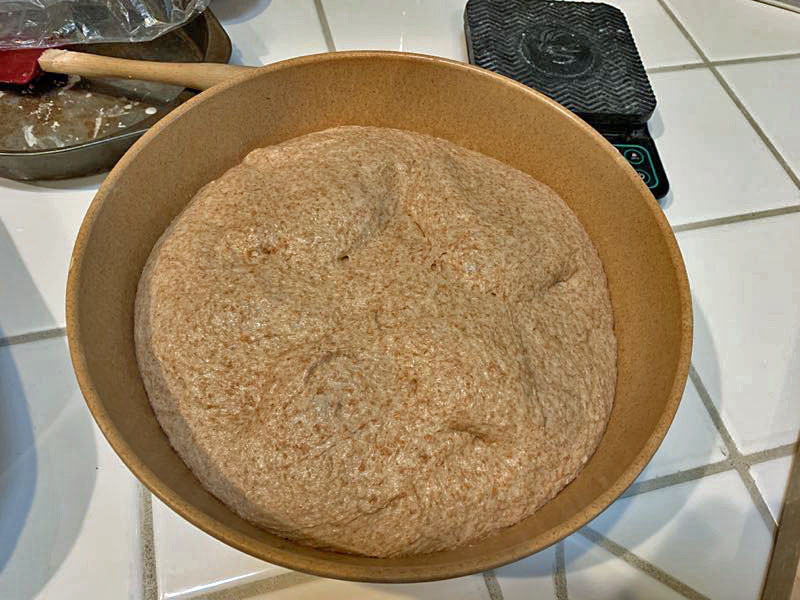
Lovely dough made with 100% home-milled Red Turkey wheat
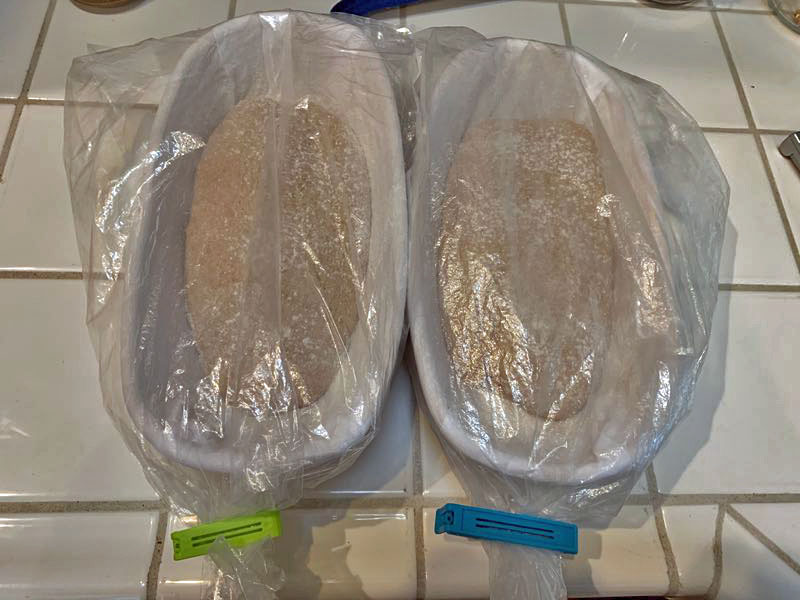
Formed loaves, ready for a 12 hour nap at 40ºF
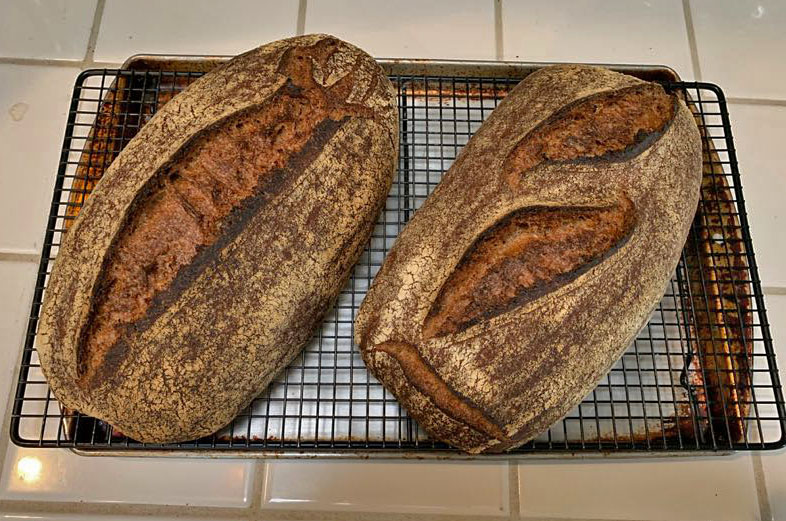
Baked loaves, cooling
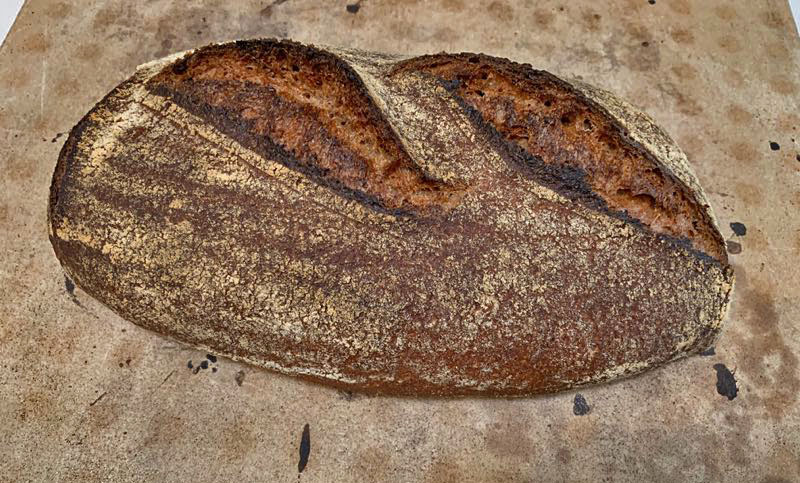
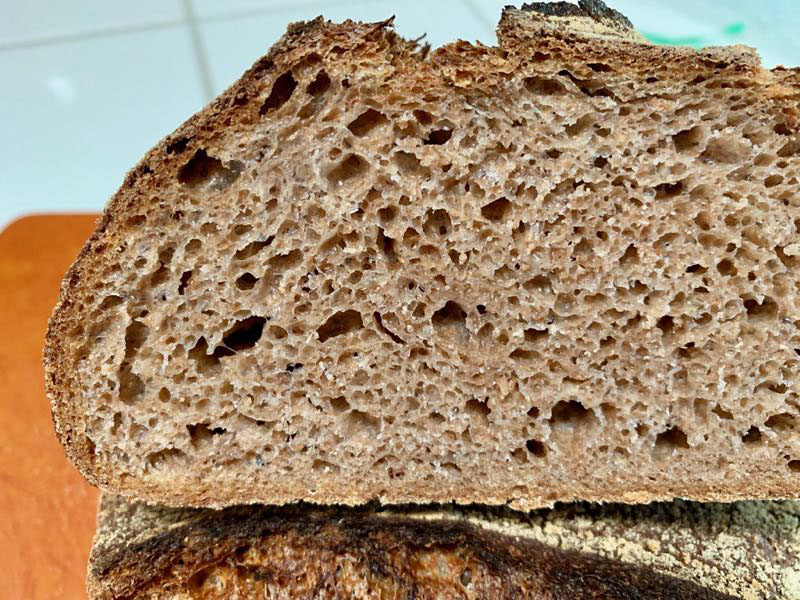
The crumb
I sliced the bread after it had cooled for about 3 hours. The crust was chewy, except for the ears which were crunchy. The crumb was very moist and tender with a wheaty and mildly sour flavor. My experience has been that this type of bread improves after a day or so.
Happy baking!
David


Comments
Your crumb is beautiful.
When I think back to my beginning years (before the Internet) of baking, all I can envision are images of “bricks”. I remember eating them and trying to convince myself how good they were. They were more suited for door stops than eating. I really believe that this site has propelled many new bakers past that dreaded stage. I appreciate Floyd!
Dan
Beautiful crumb and loaves.
Did you bring to room temp before baking after retard or bake from chilled?
I didn't measure the temperature, but I proofed the loaves for about 50 minutes before retarding them and let them stand at room temperature for about 90 minutes before baking them.
David
90 minutes is about what I'm letting my fridged loaves rest for before baking in the morning.
You've a wonderful shaping hand :-)
PR and Josey Baker are Lucy's heroes! We checked out his book at the library too - library browsing when retired is highly recommended. It has a lot of great recipes in it for sure. Your WW bread came out great. It is just the way it is supposed to be inside and out. Well done and happy baking David
A while back I tried (on the fly) a 100% whole wheat bread. http://www.thefreshloaf.com/node/57234/100-whole-wheat-100-hydration
After a few attempts it worked out, but tbh, the taste was a bit bitter for me.
Your's looks lovely...
hester
Hester, if you are interested in a milder whole wheat, I suggest you give White Sonora a try. I find it much milder that Hard Red Wheat, which is my favorite. I guess I hard core :D.
Dan
I am planning to do a 100% whole wheat that is enriched. .... in preparation for a visit to someone who loves ww sandwich bread so I'm doing TxFarmer's loaf of Whole Wheat oatmeal sandwich bread.
http://www.thefreshloaf.com/node/21575/sourdough-100-whole-wheat-oatmeal-sandwich-bread-whole-grain-breads-can-be-soft-too
That last bake of 100% ww, I think i let go too long in the proofing stages.
hester
White Sonora is very mild and not bitter IMO.
I have found that good, slow, fermentation of sourdough whole wheat breads eliminates the bitterness. Now, sometimes I get a bit of what I call "grassiness" right after the loaf has cooled enough to slice, but that is almost always gone 24 hours later.
Maybe I will try this Josey Baker bread with fresh-ground white whole wheat, just to experience the difference.
David
Excellent bake, David. Bold and a really great crumb. I have purchased Josey Baker breads and they are superb. I'd reach for yours without hesitation.
Phil
Very nice bake and write up, David. Would you mind if I featured this one on the homepage for a bit? I've been negligent in spotting and highlighting great posts recently.
David
What a magnificent loaf, David! I am madly envious, as an inexperienced baker who aspires to baking such a loaf with consistency and an absence of angst. IAt present I am still on the trail of eliminating potential barriers . When one bakes only weekly, it takes a long time to isolate faulty practices. Your expertise gives me hope. Valerie
Reflective practice and systematic, concerted error correction. It will all fall in place.
The "problem" I have is I cannot remember what I used to do that yielded inferior results.
In bread making, "everything matters," so dramatic improvements come with a myriad of tiny corrections in procedures. It's hard to isolate each one.
Happy baking!
David
I'm feeling a bit stupid here! Do you use the proportions shown in the 'Total Dough' or the 'Final Dough' to make the bread? I realize that the 'Final Dough' has the levain added, but I can't get anything to add up using the amount of levain added. Or the salt --11g vs 12 g. Really want to try this recipe.
Not a stupid question at all.
Use the ingredients in the levain section to build the levain. Then add the ingredients in the Final Dough with the built Levain to make the dough. The Total Dough is the combination of all the Levain ingredients plus all of the Final Dough ingredients.
The salt discrepancy. It could be due to a rounding error. I also noticed that other ingredients (flour for example) also don’t add up, but is close enough.
Ask away, we’re here to help.
Danny
Thanks for catching my editing error.
I originally typed the Total Dough table using Baker's formula, but then I decided to lower the salt just a bit. I forgot to correct this discrepancy. It's fixed now.
For purposes of making the bread, the information you need is in the Levain and Final Dough tables. The Total Dough table, however, gives you the most accurate picture of the dough ingredients. The Levain components are included in the flour and water items, so you can see the actual totals - especially flour and water and, thus, hydration.
I hope that is clear.
David
And this one looks simple enough to be accessible :-) Eager to try this with my T150 flour; it certainly won't give the stellar results you got, but maybe something close…
Lovely, lovely loaves.
Carole
Hi David,
These look lovely! Thank you for sharing. I assume from the comments that this was home milled grain (but I could be wrong) If you did mill the wheat, what type/types did you use?
I too am on a quest to make a 100% freshly milled sourdough, and I want that very sour flavour, but I find that even with a retard in the fridge I often end up over-proofed. (I need to pay more attention to my dough, I know - but life gets in the way!)
Carolann
If you read the note that follows the procedures, you will discover that I used Turkey Red wheat for this bread. It was milled in a MockMill100.
David
As I was milling the grain for this chilly winter week's 60% ww loaf, I found myself recalling and newly marveling at your 100% ww triumph. Wunderground says your temps are about like ours these days and I'm struggling with our annual seasonal challenge of trying to fool the dough -- always with frustratingly incomplete success, [it knows the truth] -- into thinking the kitchen and even the proofer is warmer than it actually is. I have a new 100% ww scheme I want to try, but won't go there until our temps are decidedly more Spring-like. Fighting gravity and a 55˚F kitchen is hard enough with 60% ww, much less 100%. Your bake is all the more admirable, given the time of year.
Nice baking as always Dr S,
Tom
I love my Brød&Taylor proofing box, especially in the Winter. But my kitchen never gets as cold as 55ºF! I generally doing bulk fermentation at 80ºF these days. It usually gives me a 3 hr. BF, with a 20% pre-fermented flour inoculation and 40 whole grain flours in the dough. I think it also enhances the acid balance, but I've not done a controlled experiment.
David
The overdue return of sun helped our kitchen into the 60's today and for this evening's BF, albeit in an 82˚F B&T. Your other numbers are fairly well aligned with our typical weekly bake, though 60 pct ww (half/half hard red/hard white) and 15 pct pre-fermented flour. And I always roll in some porridge for the missus :-). A cold winter kitchen makes a handy overnight retarder!
Happy Baking,
Tom
Crumb and crust look spot on David. Do did you notice a flavor difference or crumb difference in the retarded dough versus the same day baked dough?
I have not baked this bread except with overnight retardation.
It has an unique flavor - very aromatic. I couldn't figure why, so I baked another bread with which I am very familiar, a mixed grain sourdough that has about 20% fresh-milled whole wheat. (30% whole grain flour total.) The same unusual flavor appeared. I conclude it is due to the Turkey Red wheat. I need to find out if others have experienced this.
David
I think I'm losing it ?.
Not sure why I thought you baked it two ways. Anyway, I have noticed that the Turkey Red Wheat did have a stronger flavor profile than other varieties I've used. It was several years ago since I've tried it from Breadtopia.
Regards,
Ian
Lots of work but it looks like it was worth it.
David, beautiful 100% WW sourdough.
Pretty crumb and the color is just fantastic
David
Hi David
So did you bake these loaves in a dutch oven or outside with steam?
Gyorgy
These were baked on a pizza stone with steam for the first 15 minutes.
David
Thank you for sharing the beautiful results! I just received my own copy from Amazon and I can’t wait to dive in and get baking. Josey Baker Bakery mill their own flour and you can check them out on Instagram.
Hi David. I realize your post was over a year ago, but I tried to make the 100% whole wheat bread, following the directions exactly (or so I thought), but the dough was so wet by the time I got to the pre-shaping step that there was no way that I would be able to shape into boules or bâtards. I had to keep incorporating flour until I had something workable. For two loaves, I must have incorporated two cups or more! The dough didn't really rise significantly for the final proof. The final product has good flavor and crust, but is very thin and has a texture more like a german dense bread than Josey's bread. I suppose I could have gotten something wrong with the weights of the recipe ingredients, but I was pretty careful. Any comments? Thanks, Rich
Maybe you did make some mistakes in weighing ingredients. Maybe your flour was less absorbent than mine. I doubt your water is wetter than mine. ;-)
Adding that much extra flour so late in the process can't be good for the final product.
David